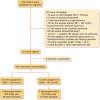A randomized controlled trial of two dialysate sodium concentrations in hospitalized hemodialysis patients
- PMID: 34792161
- PMCID: PMC9217525
- DOI: 10.1093/ndt/gfab329
A randomized controlled trial of two dialysate sodium concentrations in hospitalized hemodialysis patients
Abstract
Background: Several large dialysis organizations have lowered the dialysate sodium concentration (DNa) in an effort to ameliorate hypervolemia. The implications of lower DNa on intra-dialytic hypotension (IDH) during hospitalizations of hemodialysis (HD) patients is unclear.
Methods: In this double-blind, single center, randomized controlled trial (RCT), hospitalized maintenance HD patients were randomized to receive higher (142 mmol/L) or lower (138 mmol/L) DNa for up to six sessions. Blood pressure (BP) was measured in a standardized fashion pre-HD, post-HD and every 15 min during HD. The endpoints were: (i) the average decline in systolic BP (pre-HD minus lowest intra-HD, primary endpoint) and (ii) the proportion of total sessions complicated by IDH (drop of ≥20 mmHg from the pre-HD systolic BP, secondary endpoint).
Results: A total of 139 patients completed the trial, contributing 311 study visits. There were no significant differences in the average systolic blood pressure (SBP) decline between the higher and lower DNa groups (23 ± 16 versus 26 ± 16 mmHg; P = 0.57). The proportion of total sessions complicated by IDH was similar in the higher DNa group, compared with the lower DNa group [54% versus 59%; odds ratio 0.72; 95% confidence interval (95% CI) 0.36-1.44; P = 0.35]. In post hoc analyses adjusting for imbalances in baseline characteristics, higher DNa was associated with 8 mmHg (95% CI 2-13 mmHg) less decline in SBP, compared with lower DNa. Patient symptoms and adverse events were similar between the groups.
Conclusions: In this RCT for hospitalized maintenance of HD patients, we found no difference in the absolute SBP decline between those who received higher versus lower DNa in intention-to-treat analyses. Post hoc adjusted analyses suggested a lower risk of IDH with higher DNa; thus, larger, multi-center studies to confirm these findings are warranted.
Keywords: blood pressure; chronic hemodialysis; hemodialysis; hypotension; intradialytic hypotension.
© The Author(s) 2021. Published by Oxford University Press on behalf of the ERA.
Figures
References
-
- Dinesh K, Kunaparaju S, Cape Ket al. . A model of systolic blood pressure during the course of dialysis and clinical factors associated with various blood pressure behaviors. Am J Kidney Dis 2011; 58: 794–803 - PubMed
Publication types
MeSH terms
Substances
Grants and funding
LinkOut - more resources
Full Text Sources
Medical




